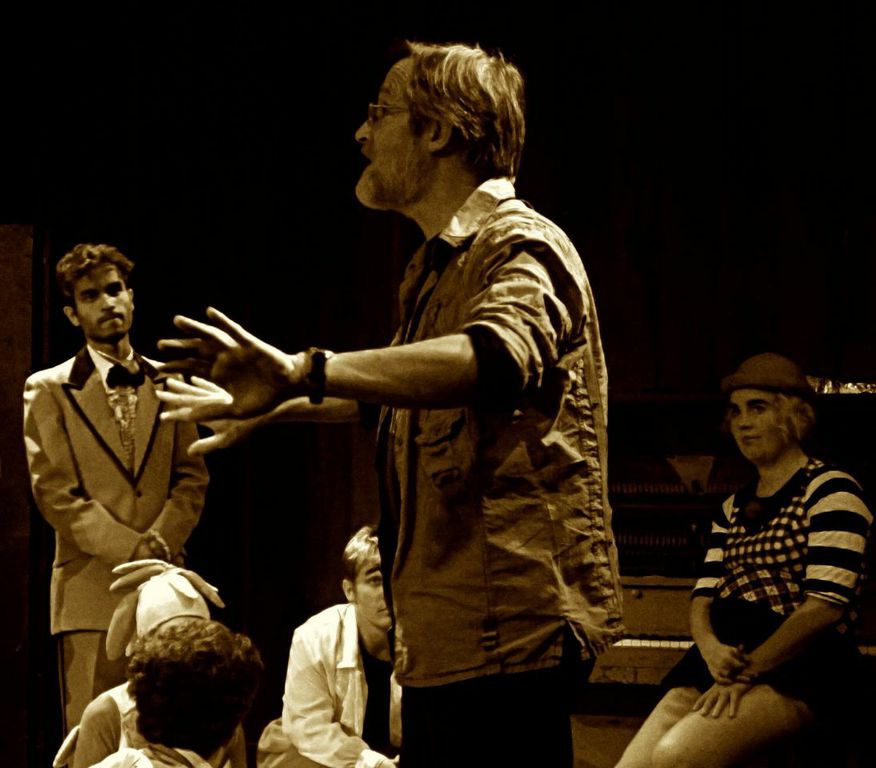(...my inquiry into why I attach myself so strongly to the work of the student; why this emotional intensity.)
I have,over the years of teaching, become aware of my manner; of the way that I am with the student. One of these epiphanies occurred in 2000 with a student who played continually with light comic anecdotes throughout clown. I kept imploring her: “You must be silent if this is all that you can play. Let your partners effect you. Listen. Only respond. You must be silent if you cannot control the quip; it is insincere and is only about your shame and insecurity.” One day, after several weeks of this pastiche, I burst with rage to my feet and heard myself in a vehement voice cry out: “Stop! Don’t you understand that for me to pull you away from yourself–for me to recognize your defaults and to encourage you towards the profitable–I must run you through my soul, like a steel rod, and stand here bleeding on the floor?!” (Well, to hear yourself say such a thing is at least informative.)
The act of “instruction” was and is consequential for me. This student could not feel or recognize what I was repeatedly requiring of her. Her habit of being “the comic” kept her from encountering the hell of confession, the stillness that lay between her and her self-discovery, the unknown of allowing her partner to have the last word. She stood at a conundrum: in order to play a character (even a personal clown), she would have to renounce her habit of self-consciousness. I required that she stop participating in class and only observe from that day on. This was not punitive, but so that she could observe the journey of her fellows without fearing her own; that with some degree of contemplation she might empathize with their struggle or flight; that she might get closer to hearing and seeing–to feeling and sensing–“the other.” Sight and recognition; to see and recognize, in this world, is vital.
Personal Statement
I have never been able to know but that I feel, never able to remember but that I experience, never been able to correct but that I find the failing expounded within myself. There is a part of the nature of my teaching that requires me to become the student. I must sense the student’s breath in my lungs for me to truly know him or her in the space before the people. Out of this relationship comes the encouragement and the reproach, the concentric (that which enfolds) and the eccentric (that which expels), the pull that gathers and the push that repulses. The kiss and the slap: a paradox. Or: love.
How do I see my responsibility as a teacher? I am a force, not a strategy. A university is an institution of the strategic and politic. In that environment, I would become a hireling; a company man whose fate is sealed by protocol and procedure. In that environment, I am negated.
As a provocateur in a classroom of sojourners I am absorbed. I become solution–not “solution” as in “the answer” but as a soluble catalyst. My spirit registers and my soul reflects. My responsibility is to animate myself. At the base, where I am most effective, I am an elemental entity: fire – creating heat, requiring change, offering comfort, a force for industry and possibly desolation; wind – arriving from and disappearing into the unknown, sometimes refreshing, sometimes laying waste; water – capable of supporting growth but also of smashing structures, violating boundaries, a danger to those who can’t float or who never learned to swim; earth – a fixed point, a vantage point, the fertile, lush, productive surface, or desolate, barren, mountainous, wastes, …losing destinations in impenetrable forests; and the depths dangerously unstable, molten, explosive.
[pullquote align=”left” color=”#553F66″ class=”” cite=”” link=””]It is at this point, and only at this point, that a resonant volume begins to open inside the student and, on the outside, the student begins to move in a dimensional world…[/pullquote]In this elemental world, against these perils, the student must be resourceful, coming to recognize both self and other, both “I am” and “it is.” Then another paradox appears as the student reaches toward the darkness, toward unknowing (and it is only by this reach that one recognizes: “I am not who I thought I was, and the visceral engagement of the unknown is the only way to myself.”) It is at this point, and only at this point, that a resonant volume begins to open inside the student and, on the out side, the student begins to move in a dimensional world. Then strength, balance, agility and endurance are developed as one admits the earth below oneself. By responding to gravity, I learn to manage my fall and it becomes the walk, and then the run, moving forward “from-to”: from home to the grocery, from my birth to my death.
(A digression. The first dialogue is between observation and imitation: discovering an indwelt state; I become stone, fire, water, air, and then a stone, a tree, a leopard, a human; reaching into, becoming a part of, pushing against; my body a sail to capture the wind, wings to embrace it demanding lift; to stand, to dig, to chop, to throw, to build, to climb, to embrace, to reject, to endure. These are efforts provoked by intent, the force of action generated via the “under-standing” of the foot through the will of the pelvis and core of the body, supported and dispersed by the intuitions of the spine; the gesture’s duration and pulse informed by the rhythm of the heart and sustained by the breath in the lungs. I arrive at knowing myself by becoming all things.)

This first dialogue uncovers the second: to discover and invent reveals a point of view. In this engagement of self and other, one recognizes the necessity for cooperation, for community and industry (one chases, the other kills; one digs, the other plants); then for families and the development of a world of human interaction, for psychological and emotional development; communities of families and the evolving of society brings the assent of culture, which is the third dialogue: the manifestation of our spiritual response to living involves belief and sublimation; seeing, hearing, feeling, tasting, smelling becomes recreating and representing, becomes transformation and revelation. To consider. To imagine. To aspire.
And so the abstraction—the metaphor, the symbol, the sign: I write, I draw, I make music and dance, I sing and tell stories, I shape objects and space and there is architecture and “the theatre,” and then another world emerges. In this new world of “art making,” 1 plus 1 equals 1. Or it equals 3. Essentially the same, and consummately, exponentially, different. This to say, there is a motion through time – a verity that endures. There is a dynamic, living reality (the true world) which resides hidden by the obvious — by intellectual constructs and pleasant “ideas”, by affinities and enthusiasm, by fear and enmity and shame and by “my self.” So authentic is this hidden world that it has the authority to decry, “Liar!” But there is no voice, no gesture, no space to resonate with the accusation.
If I taught information and not observation and experience, if I dealt with illustrations of cataclysms and not the instigation of avalanches, you might not see that this world has its double in the poetic with veritable consequences. Where the foundation of fundamental human responses for both physical preservation and spiritual exaltation are laid deep in our bones, our bowels, and our lungs, authentic and enduring.
[pullquote align=”full” color=”#fdd200″ class=”” cite=”” link=””]I write, I draw, I make music and dance, I sing and tell stories, I shape objects and space and there is architecture and “the theatre” … and an-other world emerges.[/pullquote]
I contribute to the education of the student via the application of heat and light; admittedly, this is the crude realm of practical alchemy. There are disadvantages: I cannot train a student’s training. Any gesture or word must rise out of the marrow, the liver, the stomach, the groin. The action must evidence its source and its objective; the act (the play) is always a series of one – It is. (or) It isn’t. (or) It is. But “it is” never “about” something. Primary/elemental material (which will reveal the archetypical) is the goal. I offer provocations and explorations, perspectives to awaken the soul, to develop the body, to engage and provoke the imagination, to exorcise the heart of doubt and shame and engage the lungs toward inspiration and exaltation. This is my work. If the student engages these rigorous worlds with a love for wonder and transformation, they will accrue a trajectory and a momentum. They will play in a dynamic realm where the actor becomes a poet and the theatre becomes a dangerous, POETIC REALITY.


